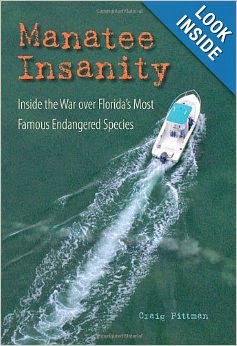In February 2010, my husband and I donned wet suits and snorkeling gear and jumped into the cold waters of Florida’s Crystal River. Our guide told us to swim to the port side of the boat, go around the bend for about a hundred yards, and turn left into a small lagoon called Three Sisters Springs.
My husband had snorkeled with the manatees a few years earlier and urged me to experience what to him, was a spiritual moment. I’d seen the wildlife in Africa, boobies and giant tortoises in the Galapagos, elephants and rhinos in India, and every tropical fish imaginable while diving in Mexico; and, of course, the whooping cranes in Texas. These were all enchanting moments for me. How could one marine mammal species top them?
As we swam closer to our destination, the water warmed and the river’s lagoon opened into a quiet manatee haven. Below the surface were at least two-dozen dozing gray blimps. After a few moments, several began to rise for a breath of air. A particular one grabbed a gulp of oxygen and on his way back down, stopped and stared me in the eye. Notwithstanding my other memorable wildlife encounters, this one left a lump in my throat. Beholding this sad, gentle visage was unlike any wildlife encounter I’d ever had before.
Not until a few weeks ago, when I picked up Craig Pittman’s book, Manatee Insanity: Inside the War over Florida’s Most Famous Endangered Species, did I fully appreciate the good fortune to have experienced a manatee moment. Pittman tells the story of the species’ struggle to survive in a rapidly changing environment. He leaves no stone unturned in his comprehensive research of the manatee’s story. More than five thousand manatees have been killed by speeding powerboats during the past four decades. The protection awarded them by the Endangered Species Act did little to keep these animals safe from boat collisions and propeller blades. Grassroots organizations, wildlife biologists, and concerned citizens who attempted to designate manatee sanctuaries and lower its speed limits for boaters, were vigorously opposed by politicians, and lobbyists for developers and construction companies. What ensued was the “Manatee War,” which pitted the rights of an endangered animal against the rights of citizens who wanted to enjoy Florida’s waterways without restriction.
Pittman is a journalist whose research skills are unsurpassed. He tells an honest, accurate story; and one full of passion, frustration, failure, and success. His book reads like a true-life thriller. Just when you think the tables will turn in favor of the manatee, a major setback occurs making the species’ survival seem impossible. I highly recommend Manatee Insanity to anyone passionate about environmental issues and endangered species and those who dedicate their lives to making a positive difference in our world.


